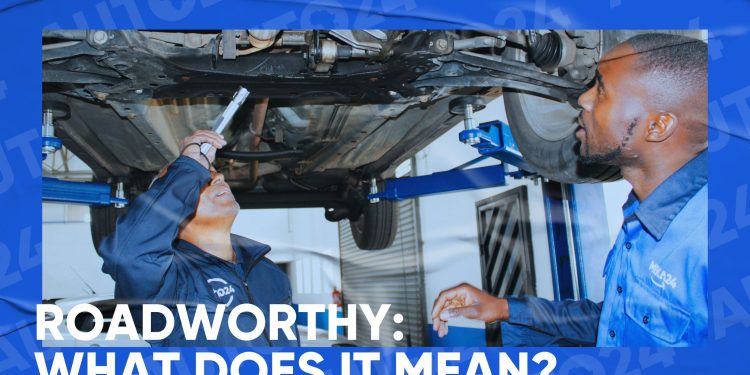Navigating South Africa’s vehicle regulations can be challenging, especially when it comes to the often-misunderstood roadworthy certificate. This essential document plays a crucial role in vehicle ownership transfers and road safety management. In this comprehensive guide, we break down everything you need to know about roadworthy certificates in South Africa – from application processes and costs to inspection requirements and common misconceptions.
Understanding the Roadworthy Certificate: Your Essential Vehicle Safety Passport
A roadworthy certificate (sometimes called a certificate of roadworthiness or road worthy certificate) serves as official verification that a vehicle meets the minimum safety standards required by South African law. This document isn’t just another bureaucratic requirement – it’s a critical safety measure designed to keep dangerous vehicles off the road.
The certificate confirms that key vehicle components and safety features have been professionally inspected and meet the standards outlined in the National Road Traffic Act. It’s important to understand that this certificate doesn’t guarantee the vehicle is in perfect condition or free from mechanical issues – it simply confirms it meets basic safety requirements at the time of inspection.
Why South Africa Requires Roadworthy Certificates
South Africa implemented the roadworthy certification system to:
- Reduce road accidents caused by vehicle defects
- Ensure safety standards for all vehicles on public roads
- Protect consumers from purchasing unsafe vehicles
- Maintain a record of vehicle condition during ownership transfers
- Meet international vehicle safety standards
When Do You Need a Roadworthy Certificate in South Africa?
Understanding exactly when a roadworthy certificate is required can help you avoid delays and complications. In South Africa, you’ll need this document in the following situations:
- Vehicle Sales and Transfers: When selling a used vehicle, a valid roadworthy certificate is legally required to complete the ownership transfer
- Vehicle Registration Changes: When changing a vehicle’s registration from one province to another
- Vehicle Modifications: After making significant modifications to a vehicle (engine changes, structural modifications, etc.)
- Re-registration: When re-registering a vehicle that was previously deregistered
- Imported Vehicles: When registering a vehicle imported from outside South Africa
- Special Classifications: When applying for vintage or special vehicle licensing
It’s worth noting that new vehicles purchased from authorized dealerships typically come with a roadworthy certificate, so an additional inspection isn’t immediately necessary.
The Roadworthy Certificate Process: A Step-by-Step Guide
Step 1: Choose an Authorized Testing Station
Roadworthy certificates can only be issued by government-approved testing stations. You can select from:
- Government Testing Centers: Usually located at traffic departments
- Private Authorized Testing Stations: Independent facilities with government authorization
Factors to consider when choosing a testing station include proximity, reputation, waiting time for appointments, and pricing. While government facilities may offer lower rates, private stations often provide faster service and potentially more flexible scheduling.
Step 2: Schedule Your Inspection
Most testing stations require an appointment, especially during busy periods. When scheduling, be prepared to provide:
- Your vehicle details (make, model, year, registration)
- Your contact information
- Your preferred date and time
- Your vehicle registration document
Step 3: Prepare Your Vehicle
Before the inspection, ensure your vehicle is in the best possible condition to pass. Key areas to check include:
- All lights and electrical systems
- Tire condition and tread depth
- Braking system
- Windscreen condition
- Fluid levels and potential leaks
- Seatbelts and safety features
- Horn functionality
- Mirror condition and positioning
Many owners opt for a pre-inspection service at their regular mechanic to identify and address potential issues before the official test.
Step 4: The Inspection Process
On the day of inspection, bring:
- Your ID document
- Vehicle registration papers
- Proof of payment (if pre-payment was required)
The inspection typically takes 45-60 minutes and includes thorough checks of:
- Structural Integrity: Frame, chassis, body
- Safety Systems: Brakes, steering, suspension
- Lighting and Electrical: All lights, horn, wipers
- Wheels and Tires: Condition, tread depth, alignment
- Glass and Mirrors: Windscreen, windows, mirrors
- Fluid Systems: Checking for leaks
- Engine and Emissions: Smoke, excessive noise
- Interior Safety Features: Seatbelts, seats, controls
During the inspection, you may be asked to wait in a designated area while technicians examine your vehicle.
Step 5: Results and Certification
After the inspection, you’ll receive one of two outcomes:
- Pass: Your vehicle meets all requirements. You’ll receive your roadworthy certificate immediately.
- Fail: Your vehicle doesn’t meet requirements. You’ll receive a report detailing the issues that need addressing before a retest.
If your vehicle passes, you’ll receive the official certificate which includes:
- Vehicle identification details
- Testing station information
- Date of issue
- Validity period
- Components inspected
- Official stamps and signatures
Roadworthy Certificate Cost in South Africa: What to Budget
The cost of obtaining a roadworthy certificate varies across South Africa, influenced by:
- The testing station you choose
- Your vehicle type and size
- Your location
- Whether it’s an initial test or retest
Current Price Ranges (as of 2024)
Based on market research across major South African cities, average roadworthy certificate costs fall into these ranges:
For Standard Passenger Vehicles:
- Government testing stations: R450-R700
- Private authorized stations: R550-R900
For Larger Vehicles (SUVs, Bakkies, Vans):
- Government testing stations: R550-R850
- Private authorized stations: R650-R1,100
For Commercial Vehicles:
- Government testing stations: R750-R1,200
- Private authorized stations: R850-R1,600
Additional Cost Considerations
Remember to factor in potential additional costs:
- Retest Fees: If your vehicle fails initially, retest fees typically range from R200-R400
- Pre-Inspection Costs: Private mechanic checks before official testing (R300-R600)
- Repair Costs: Any necessary repairs to pass the inspection
- Travel Costs: Transportation to and from testing stations
How Long is a Roadworthy Certificate Valid?
One of the most frequently asked questions is about the validity period of roadworthy certificates in South Africa. The answer is straightforward but important to understand:
A roadworthy certificate is valid for 60 days (two months) from the date of issue.
This means:
- The certificate must be used for vehicle registration or ownership transfer within this 60-day window
- After 60 days, the certificate expires and a new inspection is required
- The certificate cannot be extended, renewed, or transferred to another vehicle
- The certificate is tied to the vehicle, not the owner
The limited validity period ensures that vehicles maintain safety standards over time and that certificates reflect current vehicle conditions rather than historical assessments.
Buyer vs. Seller: Who is Responsible for the Roadworthy Certificate?
The question of responsibility for obtaining and paying for a roadworthy certificate is a common source of confusion in vehicle sales. Here’s the legal position in South Africa:
The seller is legally responsible for providing a valid roadworthy certificate when transferring vehicle ownership.
This requirement exists to:
- Protect buyers from purchasing unsafe vehicles
- Ensure transparency in vehicle transactions
- Maintain safety standards for vehicles changing ownership
However, in practice, this responsibility can sometimes be negotiated:
- Some buyers agree to handle the roadworthy process (often reflected in a lower purchase price)
- Some sales contracts specify alternative arrangements
- Some dealerships include roadworthy certification as part of their service
Regardless of private arrangements, licensing departments will not process ownership transfers without a valid roadworthy certificate in the seller’s name.
Common Roadworthy Test Failures and How to Avoid Them
Many vehicles fail their roadworthy inspection on the first attempt. Knowing the common failure points can help you prepare your vehicle more effectively.
Top 10 Roadworthy Test Failure Points
- Brake System Issues (32% of failures)
- Worn brake pads or discs
- Uneven braking performance
- Brake fluid leaks
- Handbrake inefficiency
- Lighting and Electrical Problems (24% of failures)
- Non-functioning lights
- Incorrect headlight alignment
- Indicator malfunctions
- Dashboard warning lights
- Tire Defects (18% of failures)
- Insufficient tread depth (less than 1.6mm)
- Sidewall damage
- Uneven wear patterns
- Mismatched tire sizes
- Steering and Suspension Faults (14% of failures)
- Worn shock absorbers
- Steering play exceeding specifications
- Ball joint wear
- Broken springs
- Excessive Emissions (9% of failures)
- Visible smoke from exhaust
- Failed emissions tests
- Engine running roughly
- Windscreen and Glass Damage (8% of failures)
- Cracks in driver’s line of sight
- Illegally tinted windows
- Non-functioning wipers
- Missing or damaged mirrors
- Seatbelt Issues (7% of failures)
- Frayed webbing
- Poor retraction
- Damaged mounting points
- Missing belts
- Fluid Leaks (6% of failures)
- Oil leaks
- Coolant leaks
- Brake fluid leaks
- Power steering fluid leaks
- Vehicle Structure Problems (5% of failures)
- Excessive corrosion in structural areas
- Accident damage affecting safety
- Improperly repaired previous damage
- Documentation Discrepancies (4% of failures)
- VIN/chassis number not matching paperwork
- Engine number discrepancies
- Illegal modifications not documented
Pre-Test Preparation Tips
To maximize your chances of passing first time:
- Conduct a pre-inspection with your regular mechanic
- Check all lights including indicators, brake lights, and headlights
- Inspect tire tread depth using the 20-rand coin test (if the gold band disappears when inserted in the tread, your tires are legal)
- Test your brakes for even stopping and unusual noises
- Examine your windscreen for cracks in the driver’s line of sight
- Check fluid levels and look for signs of leaks
- Test your horn to ensure it’s audible
- Verify seatbelt function by checking retraction and locking
- Listen for unusual noises from suspension when driving over bumps
- Ensure all vehicle information matches your documentation
What a Roadworthy Certificate Looks Like
A genuine South African roadworthy certificate has specific features to prevent forgery and ensure authenticity. While the exact design may vary slightly between testing stations, legitimate certificates typically include:
- The Republic of South Africa coat of arms
- A unique certificate number
- Watermarked security paper
- The full vehicle details (make, model, VIN, engine number)
- Registration details
- Testing station information with official stamps
- Issue date and validity period
- A detailed checklist of inspected components
- Authorizing signatures
It’s important to recognize authentic certificates, especially when purchasing a used vehicle, to avoid fraudulent documentation.
Can You Sell a Car Without a Roadworthy Certificate?
The straightforward answer is: No, you cannot legally complete a vehicle ownership transfer in South Africa without a valid roadworthy certificate.
The licensing department will not process the change of ownership without this document. However, there are some limited exceptions and scenarios worth understanding:
- Dealership Sales: You can sell your vehicle to a dealership without a roadworthy certificate, but the dealer will need to obtain one before reselling the vehicle
- Non-Operational Vehicles: Vehicles sold explicitly for parts or scrap (and will be deregistered) may not require a certificate
- Export Sales: Different documentation may apply for vehicles being exported
- Change of Ownership Without Registration Change: In some very specific family transfer situations, exemptions may apply (though these vary by province)
Even in these exceptional cases, proper documentation of the arrangement is crucial to protect both parties legally.
Where to Get a Roadworthy Certificate in South Africa
Roadworthy certificates can only be obtained from government-authorized testing stations. You can locate these facilities through:
- The Department of Transport website
- Provincial traffic department offices
- Vehicle licensing centers
- Online directories of authorized testing stations
When selecting a facility, consider:
- Proximity to your location
- Reputation and reviews
- Waiting periods for appointments
- Whether they offer retesting at reduced rates
- Operating hours and appointment availability
Most major cities and towns have multiple testing stations, giving you options to compare service and pricing.
Roadworthy Certificate Requirements: A Complete Checklist
This comprehensive checklist covers all major components inspected during a roadworthy test:
Identification and Documentation
- Vehicle registration papers
- VIN/chassis number verification
- Engine number verification
- License plate condition and legibility
Lighting and Electrical System
- Headlights (high and low beam)
- Parking lights
- Indicator lights (front, rear, sides)
- Brake lights
- Reverse lights
- License plate lights
- Interior lights
- Horn functionality
- Windscreen wipers and washers
- Dashboard warning lights
Braking System
- Service brake efficiency
- Handbrake/parking brake functionality
- Brake pedal condition
- Brake fluid levels
- Brake lines and hoses
- ABS functionality (if equipped)
Steering and Suspension
- Steering wheel play
- Power steering functionality (if equipped)
- Shock absorbers/struts
- Springs
- Control arms and bushings
- Tie rod ends
- Ball joints
- Wheel alignment
Wheels and Tires
- Tire tread depth (minimum 1.6mm)
- Tire sidewall condition
- Wheel rim condition
- Wheel nuts/bolts security
- Spare wheel and tools
- Tire size and specifications
Body and Structure
- Chassis/frame integrity
- Body panel condition
- Door functionality and security
- Hood and trunk latching
- Rust perforation in structural areas
- Bumper mounting and condition
Safety Equipment
- Seatbelts (condition and functionality)
- Seatbelt mounting points
- Seats (security and adjustment)
- Mirrors (internal and external)
- Warning triangle
Glass and Visibility
- Windscreen condition
- Window operation
- Window tinting compliance
- Mirror condition
Engine and Transmission
- Engine mounts
- Excessive smoke
- Fluid leaks
- Exhaust system integrity
- Transmission leaks
- Fuel system (no leaks)
Environmental Controls
- Emissions compliance
- Noise levels
Conclusion: Ensuring Your Vehicle’s Roadworthiness
Obtaining a roadworthy certificate is more than just a legal requirement – it’s an important step in ensuring your vehicle meets basic safety standards. Beyond regulatory compliance, the roadworthy process helps identify potential safety issues that could put you and others at risk on South Africa’s roads.
Whether you’re buying, selling, or maintaining a vehicle, understanding the roadworthy certification process empowers you to make informed decisions and avoid unnecessary complications. By properly preparing your vehicle and selecting a reputable testing station, you can navigate the roadworthy certification process efficiently while contributing to safer roads for everyone.
Remember that a roadworthy certificate’s 60-day validity period means timing is important, especially when planning vehicle sales or transfers. Being proactive about addressing potential issues before testing can save both time and money in the long run.
For the most current information on roadworthy requirements and authorized testing stations in your area, contact your local traffic department or visit the Department of Transport website.
Drive safely, South Africa!





